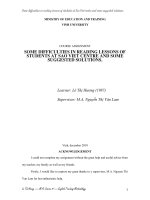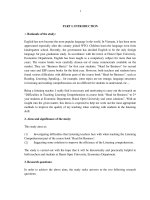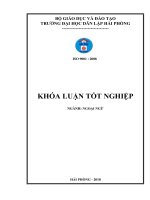difficulties in achieving
Bạn đang xem bản rút gọn của tài liệu. Xem và tải ngay bản đầy đủ của tài liệu tại đây (281.39 KB, 38 trang )
John B. Buse, MD, PhD
Associate Professor of Medicine
Chief, Division of General Medicine and Clinical Epidemiology
Director, Diabetes Care Center
University of North Carolina
Chapel Hill, NC
Difficulties in Achieving
Target A1c Values
63% of Patients With Diabetes
are Not At ADA A1C
Goal <7%
37.2%
>8%
63%
≥7%
7.8%
25.8%
37.0%
17.0%
12.4%
% of
Subjects
n = 404
A1C
Adults aged 20-74 years with previously diagnosed diabetes who participated in the interview
and examination components of the National Health Examination Survey (NHANES), 1999-2000.
Only 7% of adults with diabetes in NHANES 1999-2000 attained:
•
A1C level <7%
•
Blood pressure <130/80 mm Hg
•
Total cholesterol <200 mg/dL
Saydah SH et al. JAMA. 2004;291:335-342.
Case
DATE FPG AVG A1c
REGIMEN
SUMMARY MONITOR
3/28 150 9.8
70/30 - 36 BID
ADD MTF 500 BID
I 2/d
4/11
INCREASE 70/30 - 40 BID
INCREASE MTF 1000 BID
I+M 2/d
4/25 8.4
INCREASE 70/30 50 BID
ADD ROSIGLITAZONE 4 QD
I+M+R 2/d
5/11 162 CHANGE 70/30 - 45 Q AM, 50 Q PM I+M+R 2/d
5/22 132 6.9
SWITCH INSULINS: GLARGINE 75 QHS
+ ASPART 10 ac TID
I+M+R 4/d
6/20 89 5.6
CHANGE ASPART 1 unit/5 grams CHO
CHANGE GLARGINE 70 QHS
INCREASE ROSIGLITAZONE 4 BID
MDI+M+R 4/d
7/18 5.8
INCREASE ASPART 1 unit/3 grams
CHO
MDI+M+R 4/d
8/15 73 CHANGE GLARGINE 65 QHS MDI+M+R 4/d
9/19 5.2 CHANGE GLARGINE 62 QHS MDI+M+R 4/d
Difficulties in Achieving
Target A1C Values
What is the appropriate A1C target
Challenges
–
Late diagnosis and initiation of therapy
–
Therapeutic inertia
–
Lack of effective lifestyle intervention
–
Secondary failure
–
Adverse events associated with antihyperglycemic
therapies
–
Complexity of care
–
Role of postprandial glucose in failure
Difficulties in Achieving
Target A1C Values
What is the appropriate A1C target
Challenges
–
Late diagnosis and initiation of therapy
–
Therapeutic inertia
–
Lack of effective lifestyle intervention
–
Secondary failure
–
Adverse events associated with antihyperglycemic
therapies
–
Complexity of care
–
Role of postprandial glucose in failure
DCCT Research Group. N Engl J Med. 1993;329:977-986.
Ohkubo Y, et al. Diabetes Res Clin Pract. 1995;28:103-117.
UKPDS 33: Lancet 1998; 352, 837-853.
Slide modified from D. Kendall - International Diabetes Center, Minneapolis.
HbA1c
Retinopathy
Nephropathy
Neuropathy
Cardiovascular
disease
DCCT
9 → 7.2%
63%
54%
60%
41% (NS)
Kumamoto
9 → 7%
69%
70%
Improved
-
UKPDS
8 → 7%
17-21%
24-33%
-
16% (NS)
Intensive Diabetes Therapy:
Reduced Incidence of Complications
Potential Adverse Effects Related to
Pursuit of Stringent Glycemic Goals
Hypoglycemia
Cost
Long-term exposure to poorly studied
combinations of medications
Lessened attention to other difficult to manage
health care risks (e.g. BP, HDL, immunization,
cancer screening)
Weight gain
Risk of Progression of Complications:
DCCT Study
Skyler JF. Endocrinol Metab Clin North Am. 1996;25:243-254.
Relative
Risk
HbA1c, %
7 8 9 10 11 12
Diabetic retinopathy
Nephropathy
Neuropathy
Microalbuminuria
15
13
11
9
7
5
3
1
Rate of
Severe
Hypo.
(per 100
patient-
years)
0
20
40
60
80
100
120
Severe hypoglycemia
6
Nathan D. American Diabetes Association 2005 Scientific Sessions; June 10-14, 2005; San Diego, CA.
EDIC 12-year Follow-Up of DCCT Study
End point
Relative risk reduction (%)
(95% CI)
p
Cardiovascular
events
42 (19-63) 0.016
Nonfatal MI, stroke,
and cardiovascular
death
57 (12-79) 0.018
Incidence Rate for Complications in UKPDS:
Epidemiological Analysis*
* Expressed for white men aged 50-54 years at diagnosis and with mean
duration of diabetes of 10 years
Stratton, et al. BMJ. 321:405-412, 2000
Any diabetes
related endpoint
Myocardial
infarction
Microvascular
endpoints
5 6 7 8 9 10 11 5 6 7 8 9 10
11
Updated mean hemoglobin A
1c
160
140
120
100
80
60
40
20
90
60
40
20
Adjusted incidence
per 1000 patient years (%)
Diabetes Care 28:s4-36, 2005
/>Goal
Premeal plasma glucose (mg/dl)
2-h postprandial plasma glucose
HbA1c
ADA
90-130
<180*
<7%**
ACE
<110
<140
<6.5%
Glycemic Goals of Therapy
•
Evaluation and treatment of postprandial glucose may be useful in the
setting of suspected postprandial hyperglycemia, with the use of agents
targeting postprandial hyperglycemia and for suspected hypoglycemia.
•
More stringent glycemic goals (i.e. a normal A1C, <6%) may further
reduce complications at the cost of increased risk of hypoglycemia
Verbal Target
~100
<<200
As low as
possible w/o
unacceptable AE
Difficulties in Achieving
Target A1C Values
What is the appropriate A1C target
Challenges
–
Late diagnosis and initiation of therapy
–
Therapeutic inertia
–
Lack of effective lifestyle intervention
–
Secondary failure
–
Adverse events associated with antihyperglycemic
therapies
–
Complexity of care
–
Role of postprandial glucose in failure
Screening for Diabetes
–
Fasting plasma glucose at least every 3 years
starting at age 30-45
–
Earlier and more frequent screening in people with
risk factors:
-
Family history - Dyslipidemia (TG >150 or HDL <40/50)
-
Overweight - History gestational DM or child >9#
-
High-risk ethnicity - Hypertension (> 140/90)
-
Prior FPG >99 mg/dl - Known vascular disease
-
Characteristics of insulin resistance
American Diabetes Association. Standards of medical care in diabetes. Diabetes Care. 2004; 27 Suppl 1:S15-35.
Diabetes Guidelines Task Force. AACE guidelines for the management of diabetes mellitus. Endocr Pract. 1995;
1:149-157.
Glucose Tolerance Categories
Adapted from The Expert Committee on the Diagnosis and Classification of Diabetes Mellitus.
Diabetes Care. Supplement 1, January 2004.
Fasting Plasma
Glucose
126 mg/dL
110 mg/dL
7.0 mmol/L
6.1 mmol/L
Impaired Fasting
Glucose
Normal
2-Hour Plasma
Glucose on OGTT
200 mg/dL
140 mg/dL
11.1 mmol/L
7.8 mmol/L
Diabetes Mellitus
Impaired Glucose
Tolerance
Normal
Diabetes Mellitus
100 mg/dL 5.6 mmol/L
Impaired Fasting
Glucose
Must have two
measures to make a
diagnosis*
* One can also make the diagnosis of diabetes based on unequivocal symptoms and
a random glucose > 200 mg/dl
“Pre-Diabetes”
Effect of Early TZD Use on A1C
6.8 -
6.8 -
6.6 -
6.6 -
6.4 -
6.4 -
6.2 -
6.2 -
6.0 -
6.0 -
5.8 -
5.8 -
5.6 -
5.6 -
5.4 -
5.4 -
5.2 -
5.2 -
5.0 -
5.0 -
A1C (%)
A1C (%)
Baseline
Baseline
Switch
Switch
2-yr check
2-yr check
3-yr final
3-yr final
*
*
*
*
*
*
*
*
*
*
*
*
*
*
†
†
†
†
Rosiglitazone (n=39)
Rosiglitazone (n=39)
Pioglitazone (n=62)
Pioglitazone (n=62)
Control (n=71)
Control (n=71)
Durbin RJ Diabetes, Obesity & Metabolism 6:280-285, 2004
* P<0.001 vs. baseline;
* P<0.001 vs. baseline;
† P<0.001 vs. rosiglitazone and pioglitazone
† P<0.001 vs. rosiglitazone and pioglitazone
Difficulties in Achieving
Target A1C Values
What is the appropriate A1C target
Challenges
–
Late diagnosis and initiation of therapy
–
Therapeutic inertia
–
Lack of effective lifestyle intervention
–
Secondary failure
–
Adverse events associated with antihyperglycemic
therapies
–
Complexity of care
–
Role of postprandial glucose in failure
Based on failure, consider:
Higher order combination therapy . . .
Stepwise Management of Type 2
Diabetes: Treat-to-Failure Approach
Monotherapy… wait for failure
Combination therapy… wait for failure
Diet, exercise, lifestyle…
wait for failure
Slide provided by Steve Edelman, MD.
Patients Remain on Monotherapy
>1 Year After First A1c >8.0%
*
*May include up-titration. Length of time between first A1c >8.0% and switch/addition in therapy could include periods where patients
had subsequent A1c test values below 8%. Based on nonrandomized retrospective database analysis. Data from Kaiser Permanente
Northwest 1994-2002. Patients had to be continuously enrolled for 12 months with A1c lab values.
Brown et al. Diabetes. 2003;52(suppl 1):A61-A62. Abstract 264-OR.
Length of time that the patient’s A1c remained above 8.0%
before a switch/addition in therapy*
0
5
10
15
20
25
Metformin Only Sulfonylurea Only
Months
(n=354)
(n=2517)
14 months
20 months
Difficulties in Achieving
Target A1C Values
What is the appropriate A1C target
Challenges
–
Late diagnosis and initiation of therapy
–
Therapeutic inertia
–
Lack of effective lifestyle intervention
–
Secondary failure
–
Adverse events associated with antihyperglycemic
therapies
–
Complexity of care
–
Role of postprandial glucose in failure
Patient Centered Team Diabetes
Management
Providers are coaches
Patients are clients
Role of the Provider
in Diabetes Management
Provide guidance in goal setting and evaluation
to manage the risk of complications
Suggest strategies to achieve goals and
techniques to overcome barriers
Provide skills training (self-management
techniques)
Screen for complications
Role of the Patient
in Diabetes Management
Commit to self-care
Participate in the development of a treatment
plan
Make ongoing decisions regarding self-care
Communicate frequently and honestly with
the rest of the team
Emphasize blood glucose
control, not weight loss.
Focus on carbohydrate
foods, portions, and number
of servings per meal.
Encourage physical activity.
Use food records with blood
glucose monitoring data.
Prioritizing Lifestyle Messages
Medical
Nutrition
Therapy
Medical
Nutrition
Therapy
Compliance/Adherence
Comply: “to act in accordance with and fulfillment
of requests, demands, conditions or regulations”
Is “non-compliance” a patient or provider problem?
–
Compliance model
-
Greyhound motto: “Leave the driving to us”
–
Informed choice/empowerment model
-
Hertz motto: “We put you in the driver’s seat”
Difficulties in Achieving
Target A1C Values
What is the appropriate A1C target
Challenges
–
Late diagnosis and initiation of therapy
–
Therapeutic inertia
–
Lack of effective lifestyle intervention
–
Secondary failure
–
Adverse events associated with antihyperglycemic
therapies
–
Complexity of care
–
Role of postprandial glucose in failure









